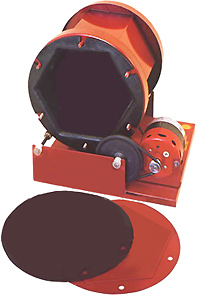Cleaning and Preservation of Coins - A Complete Guide, page 10
MECHANICAL CLEANING OF COINS: Effective Techniques and Methods
(...CONTINUED from Previous Page)
5) Cleaning with Masking Tape
Some of dug bronze coins such as common date Indian Head pennies have a very attractive smooth patina of green oxidation. Removing it will leave the coin pitted and less attractive. A simple and effective method to remove dirt from these coins is to apply a strip of high-tack masking tape to their surface.
A pencil point is then used to burnish the tape into all features, and then the tape is removed slowly. Repeat the procedure several times with fresh pieces of tape on the coin's obverse and reverse until you are satisfied with the appearance.
NOTE: Be aware that this method can remove unstable patina.
6) Cleaning with Ink-Erasing Pencil
Another means for mechanical cleaning of hard coins is to apply a hard erasing rubber in the form of a pencil. However, unused new coins should never be worked upon with a hard eraser that will cause shadowing or scratches on the face.
7) Carpenter's Glue Method
If the coins have dirt encrustation in spots, especially on the edge or between the inscriptions, and if the tarnish on the silver coins is to be retained, carpenter's glue is used. Carpenter's glue is an aliphatic resin emulsion, also referred to as "Yellow Glue."
First, the glue in sheet or bead form is heated by putting it in a suitable vessel in boiling water, after which it is applied thinly to the dirt spots. After cooling, the glue breaks off or is assisted by tapping the coins on the side with a wooden mallet, or by lifting off with a toothpick. The glue then takes the dirt encrustation with it.
8) Wet Cleaning with Rubbing with Fingers
Wet cleaning includes both the immersion of coins in warm soapy water for a few hours (the coins should be moved and turned over frequently) and rubbing wet coins with the fingers, using fine household salt (NaCl), sprinkled on most easily from a salt shaker. The salt's action is much more mechanical nature than chemical, because it can penetrate especially into the corners of the elevated coin parts or into the depressions.
9) Removal of Tar
If wood tar or coal tar from fires is involved, the coins can be placed for a few days in butter, which dissolves the tar.
10) Removal of Other Unnatural Coatings
Film residues, gummed labels, scotch tape, rubber cement and general adhesives, are removed by a brief soaking in Acetone or fingernail polish remover and wiping with a cloth. Acetone can be preserved for long periods in a small jar with a screw top.
11) Removal of Hardened Dirt and Gunk
With some limitations, the best way to clean dirt and deposits that a brass brush does not easily remove off coins is to use an ultrasonic or ultrasound cleaner. This coin cleaning method is mostly mechanical and helps in getting the dirt out of fine details and from around small inscriptions. The ultrasonic cleaning method is described in details, including practical tips, on page 14.
12) Cleaning Coins with Tumblers
To avoid cleaning hundreds of CLAD coins individually with a toothbrush and, therefore, spending a large amount of your free time, cleaning the coins with a rock tumbler is the best method to be used. The beauty of this method is that you can clean one hundred coins in about two hours and be out metal detecting while it happens!
NOTE: This method is only used for those coins that you intend to RETURN TO CIRCULATION! Tumbling coins is an abrasive procedure which can easily devalue any coin's numismatic value.
The first step is to select a tumbler. Tumblers were originally designed to polish rocks. There are several brands on the market which can be purchased at any hobby or hardware store. Tumblers range in price according to capacity, motor size and quality of construction. Quality tumblers typically range from $35 to about $100.
The next step is to select the cleaning medium. For the main ingredient, ordinary aquarium gravel is usually used. It can be purchased at any pet store. Baking soda is also added to the cleaning medium. The spice Creme of Tartar, liquid dish detergent or Borax cleanser also works well. However, when using baking soda, never add vinegar or any other acidic solution - the reaction will blow the cover off the drum!
The secret to getting the maximum performance from your tumbler is to leave some air space inside the drum. Filling the drum to its full capacity will just roll the coins around with little agitation. If you intend to keep your clad coins after cleaning, do not mix copper, clad, and nickel coins together. Dissimilar metals will stain each other.
Tumbling can also be used to clean brass relics, but like coins, you must first decide if the item you have is not valuable or fragile.